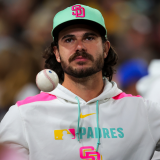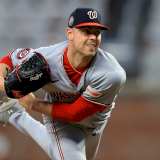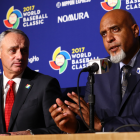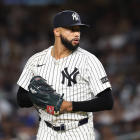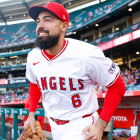What's next for Yankees after adding DJ LeMahieu, Corey Kluber? Three needs and their luxury-tax implications
The Yankees should remain in the market for a starting pitcher, among other things

On Friday, the New York Yankees signed free-agent infielder DJ LeMahieu and starting pitcher Corey Kluber in what qualify as their biggest additions this winter. LeMahieu cashed in on a brilliant two-year run in pinstripes, signing for six years and $90 million. Kluber, meanwhile, will hope that his one-year pact worth $11 million will enable him to restart his career after losing most of the past two seasons to injury.
While the Yankees have a better roster entering the weekend than they had just days ago, it's obvious that Brian Cashman's work isn't done. With that in mind, let's evaluate their Competitive Balance Tax situation before addressing three areas of need.
The Yankees were able to settle with all their arbitration-eligible players, meaning we have a clearer view of their tax number than we might otherwise. According to Cot's Contracts, the Yankees are projected to have just under $6 million in breathing room between their current CBT number ($204 million) and the $210 million tax line.
That doesn't mean the Yankees can spend only $6 million heading forward -- remember, the CBT calculation is based on average annual value, not total dollars spent, anyway -- or that they even care about avoiding the tax. They have exceeded it frequently since its installation, and they seem certain to do so again this year.
The question is how far the Yankees are willing to push into the penalty. Teams are fined 20 percent of their overage the first time they exceed the mark -- and this would count as a first-time offender year for the Yankees -- and then an additional 12 percent if they exceed the tax line by more than $20 million. There are steeper penalties for going $40 million or more over, but it seems highly unlikely that the Yankees do that.
Hypothetically, the Yankees could spend around $25 million and avoid that additional surtax. If they wanted to save around $10 million, for in-season additions and as a general rainy-day fund, then that number is closer to $15 million. The Yankees, then, could fit another Kluber-like deal into their budget with room to spare.
What the Yankees can't do -- not without punching their ticket to the surtax zone -- is bring back veteran right-hander Masahiro Tanaka for a wage similar to what he has made throughout his MLB career ($20-plus million). Who might the Yankees court instead? Let's take a look at their options at various spots, beginning with the starting rotation.
1. Starting rotation
The Yankees are projected to trot out a starting five that includes Gerrit Cole, Kluber -- fine enough -- and then some combination of Jordan Montgomery, Deivi Garcia and Domingo German, who did not pitch in 2020 while he served out the remainder of his suspension stemming from a violation of the league's domestic violence policy.
It seems unlikely that the Yankees rotation will feature those five names come Opening Day, by plan or otherwise. For instance, the Yankees could point to Garcia's age (21) and limited experience in Triple-A (40 innings) as reasons why he needs more time in the minors -- or, at least, whatever form they take come the spring and summer.
Presuming the Yankees do have an open rotation spot to play with, they could theoretically fill it by promoting a different internal option -- Michael King or Clarke Schmidt -- or by ushering Luis Severino back into the fold earlier than expected (he's now 11 months into his Tommy John surgery recovery, a process that tends to take a year-plus). The likeliest outcome, though, would seem to have the Yankees making another outside addition, either through free agency or trade.
The obvious free-agent candidate besides Tanaka is James Paxton, another member of recent Yankees teams. Beyond him, the Yankees could look to the likes of Adam Wainwright, Jake Odorizzi, Taijuan Walker, Jose Quintana or Trevor Cahill.
On the trade front, the most realistic option is Pittsburgh Pirates right-hander Joe Musgrove. The Yankees have reportedly also had past interest in Musgrove's teammate Jameson Taillon. Beyond them, the Yankees may have to gamble on someone without a great track record, like Philadelphia Phillies right-hander Vincent Velasquez.
2. Bullpen
You can expect almost every contending team to make at least one bullpen addition during the winter and ahead of the trade deadline. The Yankees don't have the flexibility to do much more than that.
Aroldis Chapman, Zack Britton, Adam Ottavino, Chad Green and Luis Cessa are presumably locks to make the roster. That leaves three spots if the Yankees carry eight relievers: one could go to Albert Abreu, who is without options and has to be submitted to waivers if he doesn't make the active roster; the other two could be filled through an internal competition between Jonathan Loaisiga, Nick Nelson, Ben Heller, Brooks Kriske, and other arms who are already on the 40-player roster.
If the Yankees do go outside of the organization, they could look to a downmarket option: an Anthony Bass, a Tony Watson, a Tyler Clippard, or even a Yusmeiro Petit. All four of those pitchers ranked at the bottom of our top-60 free-agent ranking.
3. Bench
The Yankees are somewhat restricted with what they can do on the bench, too. Backup catcher Kyle Higashioka and outfielder Mike Tauchman are both without options, suggesting they'll each make the Opening Day roster provided they're healthy. The other two spots belong to lefty first baseman Mike Ford and spare infielder Tyler Wade.
If the Yankees are going to bump either Ford or Wade to the minors -- and Ford, by virtue of his limited defensive value, seems more likely to go -- then the top candidate to take over that spot is Miguel Andujar. Andujar hasn't flourished since finishing second in the 2018 Rookie of the Year Award balloting, but he has added outfield to his defensive résumé and could slug his way back into the Yankees' plans with a strong spring.
Another challenger for Ford's spot is outfielder Greg Allen, who the Yankees recently acquired from the San Diego Padres. Allen doesn't offer much at the plate, but he's without options, and it stands to reason the Yankees may view him as an immediate speed-and-D bench piece. That secondary value could give him a leg up over Ford. (Allen's presence also gives the Yankees some cover in case they can't afford to bring back Brett Gardner on a low-cost one-year deal.)
As for Wade, the only real internal threat to his spot is Thairo Estrada, who showed some promise in 2019. The Yankees, as with most teams, like to have a backup shortstop available on the bench. That points to either Wade or Estrada making the cut.
Running back the same bullpen and bench, by and large, might not be the ideal outcome for the Yankees. But they might be willing to stomach that reality if it's the rent they pay for keeping LeMahieu and adding Kluber and another worthwhile starting pitcher.


